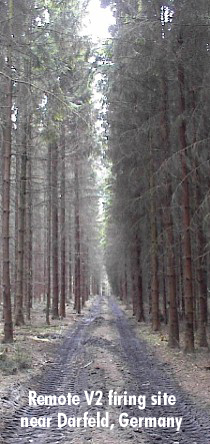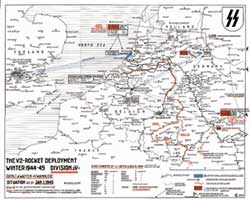 A4/V2
Rocket Operations and Deployment
A4/V2
Rocket Operations and Deployment
- Hardened Bunkers in France (Wizernes, Sottevast, Eperlecques)
- Mobile Deployment - Actual Launching Sites
- Operational Firing Timeline
- View of the Remote German Firing Procedure
- A4/V2 Support and Supply Vehicles
It was in November of 1938 that
Gruppe IV (Division IV) was set up at Wa.Prüf.11 (Abteilung 11 der
Amtsgruppe für Entwicklung and Prüfwesen des Heereswaffenamtes
= Division 11 of the Army Ordinance Department) for immediate mass production
of the A4 rocket after the completion of its development. Beginning in
January 1939, this organization, headed by Walter Dornberger, was
responsible for the development of rockets for the German army. Several
designs had already been tested and with the success of the recent A5 launches
(an A4 test-bed rocket), the Peenemünde scientists were starting the
actual work on what would become the V2 rocket. Their efforts would finally
culminate in late 1943, when the A4/V2 was being successfully fired on
a regular basis.
General Walter Dornberger had
been working toward the mass production of A4 rockets, finally securing
production authority for Peenemünde. But, on August 17, 1943, an RAF
raid on Peenemünde caused the high command to reconsider the site
because of its vulnerability to Allied air attack. The SS took A4 production
away from Dornberger and moved it to a massive network of underground
tunnels near Nordhausen. This facility was called the Mittelwerk and it
was controlled directly by the SS. There existed a debate as to whether
the A4 should be a mobile weapon. The rocket scientists favored fixed launching
complexes so that all of the prepping and last minute adjustments could
be done to the rocket. The military experts realized that a fixed site
would always be an easy target for Allied bombers.
| At Calais and Cherbourg
in France, Hitler ordered in autumn of 1942, the construction of
V2 rocket bases, where he planned to launch wave after wave of attacks
on the cities of Southern England. These sites, Watten, Sottevast
& Wizernes, consisted of giant concrete bunkers. At these locations,
the Germans intended to launch hundreds rockets per week and also produce
the liquid oxygen needed for rocket fuel. During late 1943 and early 1944,
Allied aircraft dropped tons of bombs on each of these sites. The massive
concrete structures were never operational, but became an integral part
of the V2 history.
After the Fi 103 Flying Bombs (V1) launching sites in France had been over-run by advancing Allied Armies, Hitler gave the order to open "Operation Penguin," the attack on London using the A4/V2 rocket as a mobile weapon (to begin on Sept. 15, 1944). The Allies were slowed in their advance by over-extending their supply lines and the Netherlands remained under German control. SS General Hans Kammler, now in charge of all rocket troops, gave General Walter Dornberger instructions to have all available rocket batteries ready for operations in Holland by no later than September 5th. |

Deployment Map Created by Charles Ostyn Organization
Map
|
After losing his bid to gain control of production, assembly and deployment of the A4 rocket, Dornberger had been charged with oversee and training of the first German rocket troop crews. Now, the V2 onslaught would begin from the international city of The Hague and many remote, forested areas in Holland and Germany (MAP). With the loss of the hardened bunker sites in France, the Peenemünde engineers created a mobile erector and trailer called the Meillerwagen (produced in Munich by the Meiller Corporation). This device would become a key component in the successful mobile deployment of the missile. Bythe fall of 1944 A4/V2 rockets were raining down on Allied targets.
